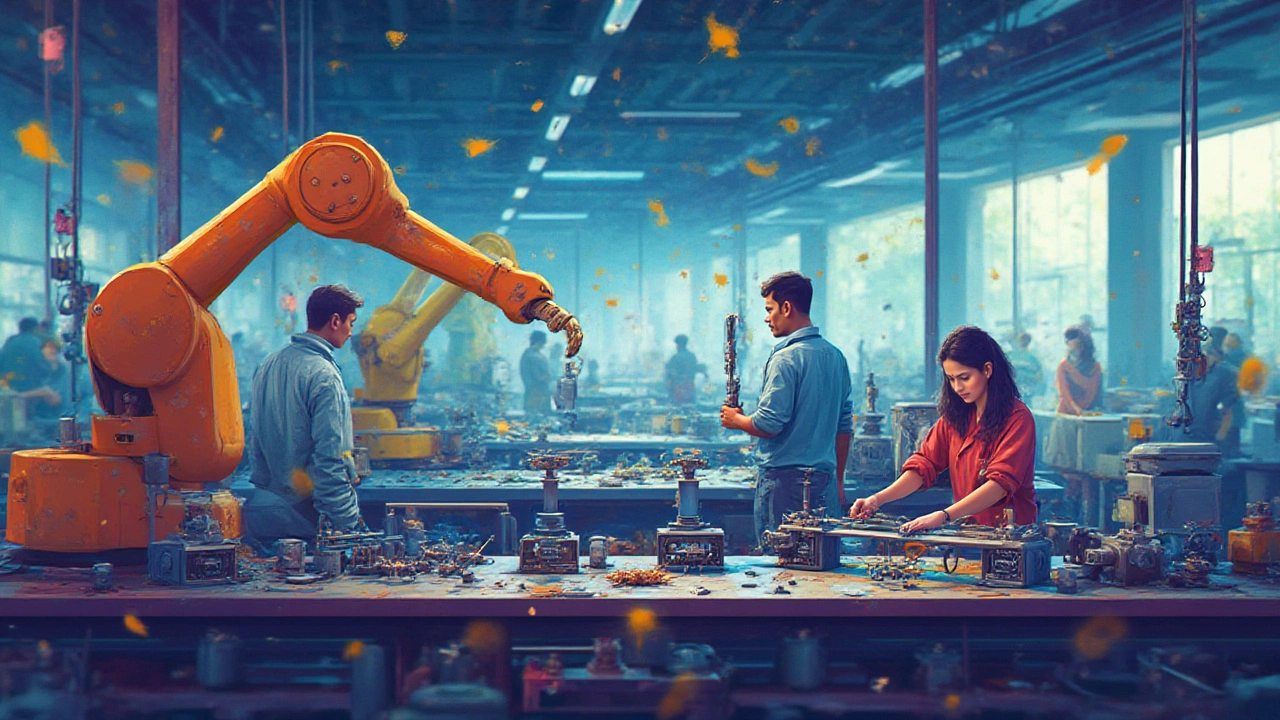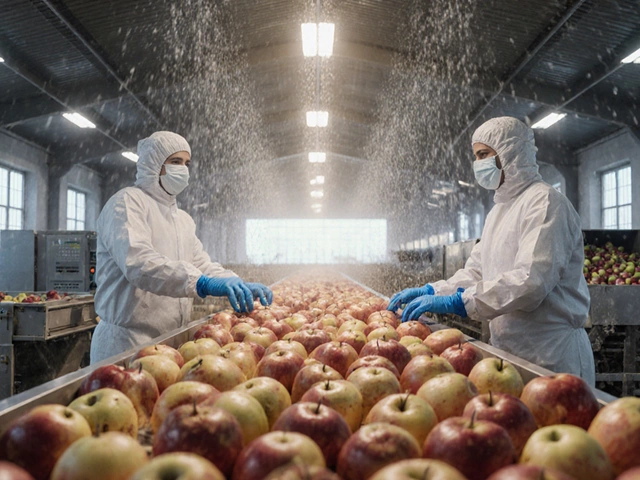America doesn’t run on coffee. It runs on making things. Whether it’s the steel beams holding up city skylines, the trucks that haul our food, or the microchips powering your phone—manufacturing is the muscle behind almost everything in daily life. In June 2025, over 12 million Americans will clock in to factories. That’s not ancient history. And these jobs are far from irrelevant. The stuff made here gets shipped across the globe. So, how exactly does manufacturing keep America ticking? Let’s dig in.
Jobs, Wages, and Opportunity
People love to talk about Silicon Valley or Wall Street, but here’s a reality check: manufacturing jobs still anchor a huge chunk of the workforce. In 2025, about 8.5% of America’s nonfarm workforce lives in manufacturing. But it’s not just about the numbers. These are jobs that pay. According to the Bureau of Labor Statistics, the average manufacturing worker earns about $31 an hour, which is above the national average. We’re not talking about flipping burgers or answering phones—manufacturing offers opportunities for skilled trades, technicians, quality control, engineers, and more.
There’s this myth that these jobs are vanishing, but that's not the truth. Automation and tech have changed the scene, but they’ve also created new roles that didn’t exist before. Think about robotics techs or 3D printing specialists. As factories evolve, so do the jobs inside them. The reality is, for every 100 jobs inside a factory, about 300 more pop up around it. These could be suppliers, logistics firms, local coffee shops—everyone benefits when a factory thrives.
Let’s talk skills. Surveys show about 2.4 million manufacturing jobs could go unfilled between now and 2028. Why? There aren’t enough skilled workers ready to operate the techy stuff in next-gen factories. This opens the door for anyone wanting a fresh start or to level-up their career. Community colleges and trade schools across the country offer training programs that take months, not years. If you want steady work, good pay, and a chance at a pension, the path is clearer than you think.
Manufacturing often props up entire towns. Take, for instance, Greenville, South Carolina, or Toledo, Ohio. These cities are dotted with plants making tires, cars, or airplane parts. When these engines run, small local businesses—from barbers to bakeries—see more foot traffic and money. It’s a ripple effect: one factory can sustain hundreds of families beyond just its workers.
Want to know which sectors are hiring? Food processing leads the pack, followed by fabricated metals, aerospace, and medical devices. If you have STEM skills or mechanical know-how, you’re golden. Women are also finding a bigger spot in the industry—nearly 30% of the manufacturing payroll is now female, and that number keeps climbing as automation levels out the physical demands.
One tip: Don’t sleep on apprenticeships. A lot of employers will pay you to learn. Programs like the Federation for Advanced Manufacturing Education (FAME) put you on the shop floor with a paycheck and real-world experience, all while setting you up for a full-time gig. Check your local state’s workforce site for more info—these opportunities are everywhere, especially in the Midwest and South.
| Top Manufacturing States (by Jobs, 2025) | # of Workers |
|---|---|
| California | 1,275,000 |
| Texas | 915,000 |
| Ohio | 769,000 |
| Michigan | 622,000 |
| Illinois | 576,000 |

Why Manufacturing Fuels the Entire Economy
The magic of manufacturing isn’t just inside the factory—it spills out everywhere. Every dollar spent on making goods in the US creates almost $2.60 in other economic activity, says the National Association of Manufacturers. That’s a bigger impact than any other sector. Say a car factory buys steel, pays employees, contracts with shipping firms, and hires maintenance people. Each link in that chain triggers more spending.
Exports? Manufacturing is the backbone. Manufactured products make up about 75% of all US exports. That’s nearly $1.39 trillion shipped every year, according to the US International Trade Administration. Selling goods abroad brings more money pouring into local communities. A strong sector here means the US isn’t a passenger in the global economy—it’s in the driver’s seat.
Trade deals and changing tariffs matter. Over the last few years, the US has renegotiated trade deals such as the USMCA (replacing NAFTA), which has helped American companies compete better across borders. This keeps jobs at home and cuts down on supply chain chaos, something everyone remembers from the pandemic days when simple things like masks or car parts ran short.
Look at the supply chain crunch. When factories in America run short on parts because everything’s imported, things grind to a halt. This was painfully clear in 2020 and 2021. That’s why more companies “reshored” manufacturing—bringing production back to US soil. It’s about being resilient, not just cheap.
Small and medium-sized companies, not just big names like Ford or Boeing, make up 98% of all US manufacturing firms. These shops are nimble and innovative. When the inflatable paddleboard craze hit, it was small Kentucky and Idaho factories ramping up, not the giants. These companies hire locally and are often family-owned, sinking roots in their hometowns.
Another biggie is taxes. Manufacturing generates billions in local and federal tax revenues every year. This cash pays for roads, schools, internet cables—stuff everyone depends on. So, if you’re driving on a new highway or you just got fiber internet for Netflix, thank your local factory.
| Manufacturing Sector Share (2025) | Percent of US Exports |
|---|---|
| Automobiles & Parts | 18% |
| Machinery | 15% |
| Electronics | 11% |
| Pharmaceuticals | 9% |
| Aerospace | 20% |
Here’s a cool tip if you run a business: look into the Manufacturing Extension Partnership (MEP). It’s a nationwide program that helps small shops modernize and cut costs. They’ll walk you through better supply chain management or show you how to get ISO certified if you want to export. The difference between surviving and thriving can come down to tech upgrades, and these programs make it affordable.
And don’t forget the green side. New factories use energy-smart tech to cut down waste and shrink carbon footprints. “Smart” factories monitor machines in real time, fix breakdowns before they happen, and use only the power they need. In 2024, manufacturing was responsible for about 23% of all greenhouse gas emissions in the US. With climate rules getting tougher, companies are racing to shrink that number. You’ll see more factories powered by wind, solar, and even hydrogen in the coming years.

Innovation, Technology, and the Future of Making Things
Those who think manufacturing means grease and wrenches haven’t visited a modern plant. Today, these places buzz with advanced robotics, artificial intelligence, and 3D printers humming away. You won’t find repetitive grunt work so much as machines and humans working side by side. American factories lead the world in adoption of “Industry 4.0”—a fancy label for creating “smart” factories using the cloud, sensors, and real-time data.
Here’s something wild: the US spends about $320 billion every year on research and development in the manufacturing sector. That’s almost half of all R&D spending nationwide. Innovations invented on the shop floor often bleed into daily life—lasers, MRI scanners, even Bluetooth all started as manufacturing breakthroughs. Smartphones wouldn’t exist without precise chip facilities, and the medicines we rely on use biotech systems built by manufacturing engineers.
Have you heard of additive manufacturing? That’s just 3D printing. It lets companies make airplane parts, dental crowns, and shoe soles faster and lighter with less material. Boeing, for example, 3D prints more than 50,000 airplane parts right now. This makes planes cheaper to build and more fuel-efficient. If you’re into sneakers, Adidas 3D-prints midsoles for a custom fit. These aren’t just cool tricks—they’re changing how entire industries work.
Automation is scary for some workers, but it tends to create more interesting and safer jobs. Instead of screwing the same bolt all day, people now program robots, troubleshoot systems, and run quality checks. And those robots? They don’t call in sick or get bored, meaning production is more stable and employees have time to focus on smarter tasks. In the past five years, the US added more robots than any other country except for China.
Let’s not forget about biotech. COVID-19 put a big spotlight on vaccine manufacturing. Companies like Pfizer, Johnson & Johnson, and Moderna built facilities that can churn out billions of doses a year. But innovation isn’t just about speed—it’s also about safety and reliability. Getting a new drug to market used to take 10 years. Now, advanced manufacturing slashes that timeline, taking the pressure off during health emergencies.
Startups are getting in on the action. Take Relativity Space in Los Angeles. They’re building rockets almost entirely with 3D printing. This sliced launch prep times from years to months. There’s also a boom in artificial intelligence that helps spot tiny errors before expensive products leave the factory. AI can predict when a turbine may fail or let a food plant instantly trace contamination, which prevents disaster—and recalls that cost millions.
Here’s a tip if you have a great product idea: check out Maker Spaces in your area. These are shared workshops with pro equipment (think $200,000 3D printers and laser cutters) where you can build one-off prototypes for cheap. Even big automakers like Ford invest in these spaces to help their engineers think outside the box.
Looking forward, “reshoring” is still a hot topic. More companies are pledging to move production back from overseas. That means shorter wait times, fewer supply chain headaches, and more jobs staying home. Plus, these local plants are often more sustainable. They don’t have to ship goods half a world away, slashing emissions and freight costs.
America’s manufacturing story is constantly being rewritten—overcoming trade wars, pandemics, and the rise of automation. The sector is a testing ground for new inventions, green tech, and upskilling programs. Whether you’re looking for a solid job, want your town to thrive, or you’re just glad your gadgets arrive fast, manufacturing has your back.
Manufacturing isn’t dusty, dying, or dull. It’s wired into the backbone of everyday life, and its future is anything but boring. From virtual reality headsets to the wheels under your car, making things is what keeps America moving forward.






